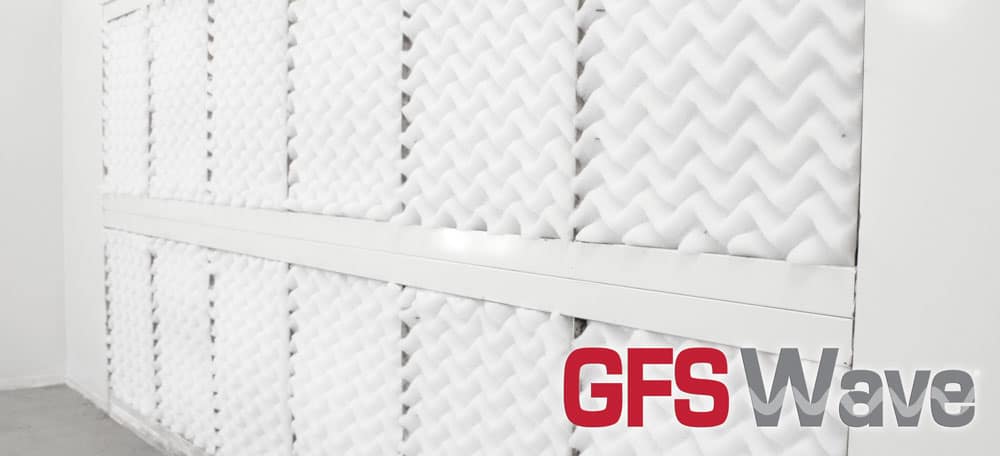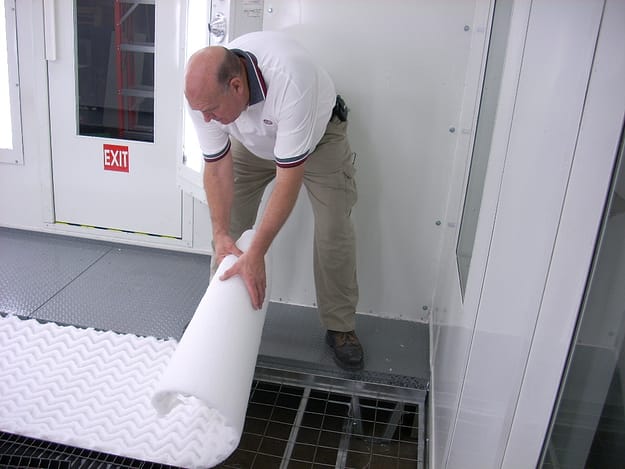
Choosing the correct filter for your paint booth can be a daunting task. The choices you make will have a direct impact on everything from the efficiency of your paint booth and the quality of the end product to spray booth maintenance costs and the safety of technicians. This guide will introduce you to and give insight into the different types of filters found throughout your srpay booth, as well as maintenance tips to keep your paint booth running efficiently.
Depending on your paint booth setup, your first line of filtration defense may be air make-up filters.
Located in the air make-up unit (AMU), these filters trap large particles before air reaches the AMU, providing pressurized air to the spray booth. The filters play an important role in extending the life of more expensive filtration down the line. Air make-up filters come in multiple varieties, such as pad filters, panel filters, cleanable aluminum filters and pocket and bag filters.
When troubleshooting airflow issues, air make-up filters are a good place to start. If your paint booth has insufficient airflow, your air make-up filters may be dirty or clogged. If your spray booth has too much airflow, check to ensure the air make-up filters are correctly in place. Also keep in mind that with air make-up filters in many units, a burner or cooling coil is located directly behind the filter frame system, so care must be taken that filters do not come in contact with the burner or coil.
You likely wouldn’t know it because you wouldn’t actually be able to see it, but it takes only particulates around 10 microns (0.0004 inches) to cause defects in your paint job. This is the importance of intake filters — they provide clean, filtered air to the paint booth, eliminating foreign particles that can contaminate your paint job.
The type of spray booth also affects the type of filter required. For cross draft paint booths, the filters are often internally supported polyester panel filters or linked panel filters. These filters are typically designed to be installed without the aid of clips or other mounting hardware, while creating a leak-free static fit when inserted into the frame. A common type of filter used in downdraft paint booths is a diffusion-type media pad. This type of filter allows the airflow to spread uniformly throughout the spray booth, ensuring optimal conditions for applying coating.
Because each type of paint booth uses different filters, the efficiency of the filters also differs. Polyester panel filters or linked panel filters for a cross draft paint booth vary from MERV 6-8 products; GFS provides MERV 7 products in its cross draft paint booths. The diffusion-type media pad found in downdraft paint booths is much more efficient, with at least a MERV 10 rating. This rating ensures an internal cleanroom atmosphere that removes more than 99 percent of all particulates 10 microns or larger from the air entering the paint booth.
While intake filters ensure you are working with clean air from the start, exhaust filters make sure the air leaving the paint booth is safe for the environment, while also keeping potentially dangerous chemicals from remaining in the airflow of the spray booth. Exhaust filters capture solid and liquid aerosols that painters can be exposed to through inhalation or dermal adsorption. The filters also keep those highly toxic materials from being released into the environment after passing through the spray booth.
Another purpose of exhaust filtration is to protect your paint booth’s fans, stack and plenum from the buildup of overspray contamination. In order to achieve this, exhaust filters must be able to hold enough paint to avoid constantly replacing the filters, while at the same time providing a minimal pressure drop within the paint booth to ensure particulates don’t harden and end up on the painted surface.
Most paint booths use single-stage filters. The type of exhaust filter used is the same for cross draft and downdraft spray booths, but the location and frame configuration differ. In cross draft spray booths, plenum and wall filters are common, whereas in downdraft spray booths, exhaust pit filters are used.
The filters are generally made of multilayered polyester and/or fiberglass. Differences in fiber configuration, density and composition impact how exhaust filters perform.

GFS Wave paint booth filters are extremely versatile single-stage filtration media for use as paint booth exhaust filters. They are included in GFS paint booths, accommodating all paints and a wide array of spray applications, from clear coats to high solids. Compared to normal polyester exhaust media, the patented wave pattern of the filter provides 2.3 times more surface area for every square foot of face area in an existing frame system.
GFS Wave is a nonwoven polyester media comprised of coarse and fine, standard and low-melt fibers chosen for performance in overspray collection applications. This means that the fiber blend, along with the wave pattern, enables paint-laden air to be captured across the surface and within the depth of the media, extending filter service life and reducing operating costs.
The filters provide 99.94 percent particulate removal efficiency and a holding capacity of 4.4 pounds. GFS Wave filters comply with the requirements of NFPA 33, OSHA and UL 900. For best results with GFS Wave filters, make sure the filters are installed with the waves running horizontally. Putting the filter in the wrong way reduces its ability to capture and retain more overspray.
Just as important as deciding which filters to use is establishing a regular schedule for changing intake and exhaust filters. The cleanliness of your spray booth and the work you do within depend heavily on it. Clogged or overloaded filters may not allow proper airflow through the paint booth, causing dust or overspray to recirculate through the spray booth and affect the finish of your paint job.
Beyond that, it is also an important step in ensuring your paint operation meets health and safety standards required by the NFPA and OSHA. In more severe situations, clogged filters may create flammable or explosive conditions within your paint booth.
With so many different styles and brands of filters, they reach their target reading and require replacement at varying rates. These rates also depend upon the paint type, paint booth design, fan speed, temperature and spray equipment.
One way to establish a change-out schedule for exhaust filters is to compare readings from a manometer or magnehelic pressure gauge with the paint booth manufacturer’s specifications. Without a pressure gauge, it is best to establish a strict maintenance schedule based on the volume of spraying taking place on a day-to-day basis. Ultimately, it is best to work with your spray booth manufacturer or filter supplier to design an effective schedule for changing your filters that finds a good balance between filtration needs and cost efficiency in your paint booth’s performance.
Paint booth filtration can be more complex than you originally thought. At GFS, we have a dedicated parts and filters team to aid you in the process and supply you with filters for all of your paint booth filter needs.
One of the best ways to highlight your business is through a story that you can share across your online platforms. It humanizes your business and shows that your business can make a meaningful impact. Your testimonial would be used as a project profile on the GFS Booth Blog and can be shared on your website and/or social media channels.
Complete this form and we’ll be in touch to showcase your company.

Shop a variety of GFS aftermarket products, including booth protection products and mobile accelerated curing units. And enjoy the convenience of fast and free ground shipping throughout the contiguous United States.

Located at GFS’ headquarters in Osseo, Wisconsin, the Center for Excellence is an innovative facility featuring an automotive refinish training center, as well as a separate space dedicated to technical product training.

GFS is continuously searching for talented, ambitious individuals to join our team. We aim to provide our employees with every opportunity to make an impact on the company and find their niche along the way — weather in a production, field services or an office position.